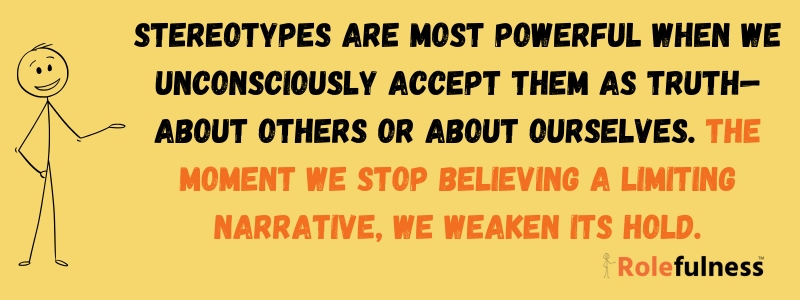Breaking stereotypes requires more than boldness. It requires consistency, discipline, and an internal compass—a deep sense of purpose within the role. Even after retiring from competition, Mouton continued to expand her influence. She co-founded the Race of Champions, and later led the FIA Women & Motor Sport Commission, advocating for inclusion and opportunity. In 2024, she received the FIA Lifetime Achievement Award.
Michèle Mouton's journey is a powerful reminder: inhabiting a role with purpose, against the odds, is not only an act of personal fulfillment—it can be an act of cultural transformation.
How to Break a Stereotype

Before a stereotype can be broken out in the world, it must first be rejected within. Stereotypes are most powerful when we unconsciously accept them as truth—about others or about ourselves. The moment we stop believing a limiting narrative, we weaken its hold.
Refusing to internalise a stereotype doesn’t mean denying its existence—it means refusing to let it define your sense of possibility. It’s an inner act of resistance, and often the beginning of real transformation.
As we discovered with the Women Drive Better if Not Stereotyped study, research shows that expecting to perform poorly—because of a stereotype—can actually lead to poorer performance. Belief becomes a self-fulfilling prophecy. When you believe in your ability, and the stereotype is removed or reframed, performance improves. This is the power of the mind–behaviour connection at work.
To break a stereotype, start by not believing it applies to you.
The next step is to actively disprove it through action. Refusing to internalise a stereotype is powerful—but what cements its breakdown is embodying the counter-narrative.
This means showing up fully in the role, doing the work, and letting your behaviour speak louder than the bias. It’s not about trying to prove something to others—it’s about living in alignment with your truth, skill, and potential.
This is what Michèle Mouton did. She didn’t argue the stereotype; she drove past it. By doing the role—and doing it well—she challenged not only what others believed about her, but what they believed about what a woman could be in that space.
But how does one get started? Where does the belief come from that a stereotype can be broken? It often begins with a role model.
Breaking stereotypes is hard to do in isolation. Seeing others who have done it gives us courage, clarity, and a roadmap. Whether it's a trailblazer like Michèle Mouton or someone in your community quietly redefining a role, role models help expand your sense of what’s possible.
And in time, as you inhabit the role fully and authentically, you may become that model for someone else. You become what others aspire to be. One of the most powerful ways to break stereotypes isn’t just to live against them—it’s to make it easier for others to do the same.

One role we can all embrace is to support others in breaking stereotypes so they can discover and pursue their unique role in life. Be a voice of encouragement as they find their way—regardless of their gender, race, age, or background.
Returning to the 20th-century personalities and athletes we’ve explored, each one found—or created—a unique role in life. And for each of them, that role gave rise to what the Japanese call ikigai: a sense of purpose, meaning, and deep life satisfaction. Their roles became a means—and a freedom—to express themselves, transcend social boundaries, serve others, and ultimately experience a life worth living.